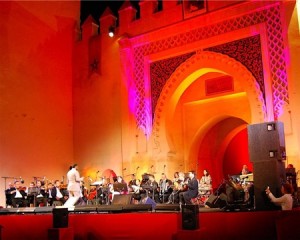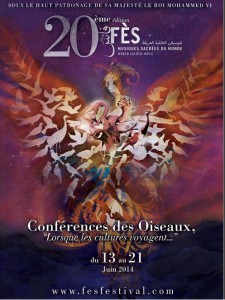Posts Tagged ‘Fes Festival of World Sacred Music’
From 22-30 May 2015, the ancient city of Fes will host the 21st edition of its world famous Sacred Music Festival. The origins of Fes lie in the 8th century by Idris I, who is known for bringing the religion of Islam from…
The Fes Festival of World Sacred Music, celebrates its 20th anniversary this year with the theme Conference of the Birds: Journey of Cultures. It has been twenty years of a musical, spiritual and artistic journey exploring the cultures and traditions of the world, revealed in ever greater depth through concerts,…

Celebration is an important aspect of Moroccan culture. Morocco is an exciting and entertaining country that lays claim to cultural, historical and religious holidays and festivals. At any given point of the year there is a Moroccan city or Berber community hosting glorious festivities. Moroccan celebrations can last anywhere from a few days up to two weeks. The exception is Ramadan which lasts for thirty days. While Moroccans celebrate numerous Muslim and national festivals through the year, the dates for most of their religious festivals are based upon the lunar calendar. Therefore it is difficult to predict when religious holidays will fall within the western calendar utilized by most people in the world.
During Moroccan festivities, one can expect to encounter fasting, dancing and feasting – all depending on the type of holiday being celebrated. The Muslim festivals and religious holidays are traditionally observed by all Moroccans regardless of how long they last. They are also often observed by foreigners living in Morocco.
Some famous festivals are: the Almond Blossom Festival which marks the time when these trees bare their leaves in splendid shades of pinks and whites; the Festival of Roses in El Kelaa M’Gouna which gives way to thousands of blooming roses whose scents lingers all during the festival whereby the annual Ms. Roses is chosen; the Fes Festival of Sacred World Music, the Gnaoua Festival, the Timitar Festival of Agadir celebrating Amazigh (Berber) music and the Sufi Festival. Morocco’s leading festival that commands top attendance is The International Film Festival of Marrakech; for its attraction of film makers from around the world who flock to show their feature films and shorts. Every festival is an adventure and offers an opportunity to connect with locals to experience Moroccan culture. Moroccan festivals and celebrations are fascinating and immensely enjoyable therefore visiting during one of them can greatly enhance your trip to the country.

Travel Exploration & Authentic Asia Present The Fes Festival of World Sacred Music & Morocco Cultural Tour – Hosted by Music Expert, Joel Davis
This 13 Day/ 12 Night Morocco Fes Music Festival Tour will offer a celebratory opportunity for those who are passionate about Sacred World Music to enrich their palate with a variety of international sounds ranging from Andalusian Classical music to African, Asian, Moroccan Sufi and more while taking a journey across Morocco’s Imperial Cities, Majestic Landscapes, the Sahara Desert and Valley’s. This all inclusive 13 Day/12 Night Morocco Private group tour guarantees combined 4/5 Star accommodations at charming Riads and luxury Moroccan hotels and properties, private transport, historical guides, museum and monument entrance fees along with tickets to the Fes Festival of Sacred World Music. Don’t miss out on this special opportunity to travel to Fes, Morocco and other regions such as Marrakech, Ouarzazate and the Sahara Desert with a music guide and historical guides who will bring depth and understanding to the meaning of Morocco’s music and vast cultural traditions.

Travel Exploration is proud to present the final music and conference schedule for the Fes Festival of World Sacred Music. The Fes Festival Of World Sacred Music’s 17th Edition will take place from June 3rd – 12th, 2011. The Fes Music Festival can be attended by taking a 13 Day/ 12 Night Morocco Tour with Music Host, Joel Davis which includes discovers of Morocco’s Imperial Cities, the Fes Festival of World Sacred Music and the Sahara region. Discovering Fes and the Fes Festival can also be done on a private journey to Fes. This immense undertaking of a Fes Festival Program in the city of Fes, Morocco is once again spearheaded by Mr. Faouzi Skali. Mr. Faouzi Skali has a Doctor in anthropology, ethnology and religion sciences. Faouzi Skali was born in Fes Morocco in 1953. Mr. Skali founded the international symposium A soul for the globalization – since 2001 – in parallel of the Festival of World Sacred Music in Fes. Those of us who know Mr. Faouzi Skali’s word and his commitment to peace and a greater Fes are pleased to have him back at the helm. The 17th Edition of the Fes Festival of World Sacred Music is going to be like none other. At a time when the Muslim world is looking for reform towards democracy and peace, Morocco once again leads with a commitment to these efforts linked to culture, arts and community. The mix of musicians from around the world at the 17th annual Fes Festival within the modernized, peaceful and progressive country of Morocco is surely to be at the threshold of the world’s eyes and an opportunity for world and spiritual music to once again bridge the gaps that exist among us.






